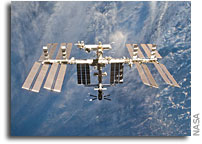Teams Working Cooling System Issue; Station Crew Carries on With Research

The International Space Station’s Expedition 38 crew worked Thursday with the team on the ground to deal with a malfunction that occurred Wednesday on one of the station’s two external cooling loops that uses ammonia to prevent station systems from overheating.
On Wednesday, the pump module on one of the space station’s two external cooling loops automatically shut down when it reached pre-set temperature limits. These loops circulate ammonia outside the station to keep both internal and external equipment cool. The flight control teams worked to get the cooling loop back up and running, and they suspect a flow control valve actually inside the pump module itself might not be functioning correctly.
That flow control valve regulates the temperature of the ammonia in the loop so that when the ammonia is re-introduced into the heat exchanger on the Harmony node it does not freeze the water also flowing through the exchanger.
At no time was the crew or the station itself in any danger, but the ground teams did work to move certain electrical systems over to the second loop. Some non-critical systems have been powered down inside the Harmony node, the Kibo laboratory and the Columbus laboratory while the teams work to figure out what caused the valve to not function correctly and how to fix it.
The station is currently in a stable configuration and the crew is safe. The science and research mission continues aboard the station, and the science data collected so far is not at risk.
Mission managers have deferred the decision on whether to proceed with or postpone the launch of the Orbital Sciences’ Cygnus commercial cargo craft until more is known about the flow control valve issue. Cygnus is currently scheduled to launch Dec. 18 from Wallops Flight Facility in Virginia and rendezvous with the station on Dec. 21.
The Expedition 38 crew members also tackled a variety of other tasks Thursday, including maintenance work and scientific research.
Flight Engineer Mike Hopkins began the day with some work on the Advanced Resistive Exercise Device, or ARED, which allows the crew to perform a wide range of weightlifting exercises in the weightless environment of the station.
Hopkins later installed a jumper in the Quest airlock to provide contingency power to the airlock’s secondary shell heaters. He also prepared the U.S. spacesuits for some upcoming scheduled maintenance.
Flight Engineer Rick Mastracchio deployed eight bubble detectors for the RaDI-N experiment, which seeks to characterize the neutron radiation environment of the station.
Flight Engineer Koichi Wakata removed and stowed a NanoRacks platform. NanoRacks provides lower-cost microgravity research facilities for small payloads utilizing a standardized “plug-and-play” interface.
Wakata also spoke with students in Kyoto, Japan, via the amateur radio aboard the station.
On the Russian side of the complex, Commander Oleg Kotov continued unloading cargo from the Progress 53 cargo vehicle that docked to the station on Nov. 29.
Kotov later collected micro-accelerometer data for the Identification experiment, which examines the station’s dynamic loads during events such as dockings and reboosts.
Flight Engineer Sergey Ryazanskiy continued the replacement of fans in the Zvezda service module with low-noise units and used a sound level meter to measure the results.
Flight Engineer Mikhail Tyurin conducted routine maintenance on the life support systems in the Zvezda service module. Afterward, he performed the Uragan Earth-observation experiment, which seeks to document and predict the development of natural and man-made disasters on Earth.
On Wednesday, the first of two reboosts of the station took place to raise the station’s orbit and set up the proper phasing and trajectory for Russian vehicle launches and dockings in 2014. The 7-minute, 41-second firing of the ISS Progress 53 cargo craft’s thrusters also places the station in position for the arrival of Orbital Sciences’ Cygnus commercial cargo vehicle this month.








